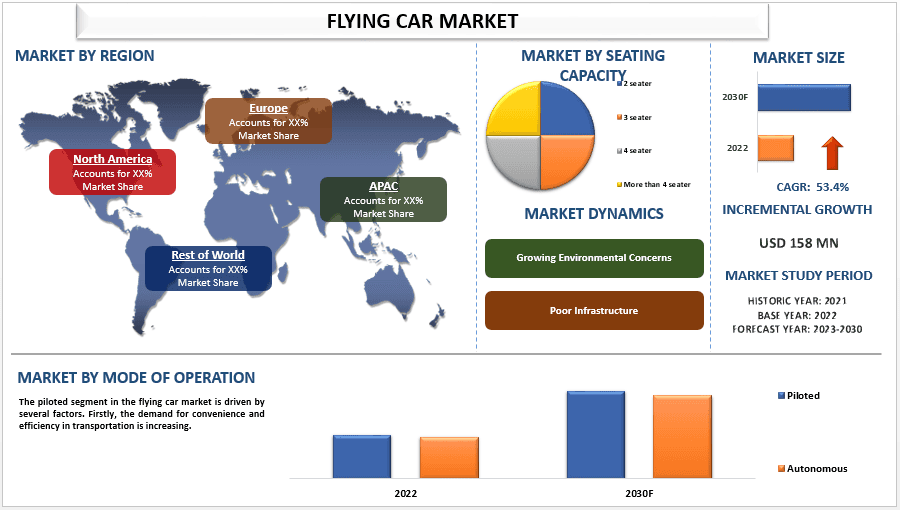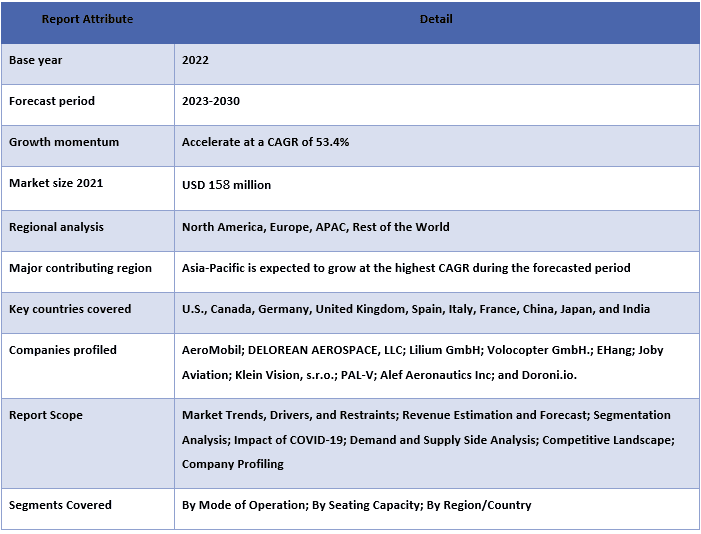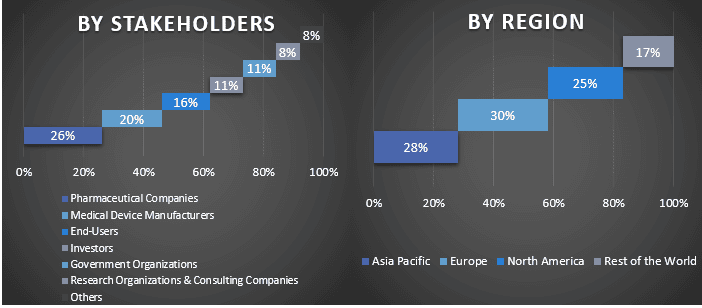- Home
- About Us
- Industry
- Services
- Reading
- Contact Us
Flying Car Market: Current Analysis and Forecast (2023-2030)
Emphasis on Mode of Operation (Piloted and Autonomous.); Seating Capacity (2 seater, 3 seater, 4 seater, and more than 4 seater); Region/Country.

The flying car market was valued at USD 158 Million and is expected to grow at a strong CAGR of around 53.4% during the forecast period (2023-2030) owing to rising prevalence of cardiovascular diseases. The flying car market is a rapidly growing industry that aims to provide a new mode of transportation, combining the convenience of cars with the freedom of flight. Flying cars, also known as personal air vehicles (PAVs), promise to revolutionize urban transportation by alleviating road congestion and reducing travel time. The market for flying cars has garnered significant interest from both established companies and start-ups, with numerous players investing in research and development to bring these vehicles to market. Several automotive and aerospace giants, such as Airbus, Uber, and Boeing, have announced their foray into the flying car market, while startups like Terrafugia, Kitty Hawk, and Volocopter are also actively developing their protomode of Operations. The demand for flying cars arises from the increasing urbanization and population density in major cities. With limited road space and heavy traffic, flying cars offer a potential solution to these issues by utilizing the underutilized airspace. These vehicles are designed to take off and land vertically, requiring less infrastructure compared to conventional aircraft. Some models also feature hybrid capabilities, allowing them to drive on roads as well.
Some of the major players operating in the market AeroMobil; DELOREAN AEROSPACE, LLC; Lilium GmbH; Volocopter GmbH.; EHang; Joby Aviation; Klein Vision, s.r.o.; PAL-V; Alef Aeronautics Inc; and Doroni.io. Several M&As along with partnerships have been undertaken by these players to facilitate customers with hi-tech and innovative products/technologies.
Insights Presented in the Report
“Amongst mode of operation, the autonomous category to grow with significant CAGR during the forecast period”
Based on mode of operation, the market is bifurcated into piloted and autonomous. The autonomous is anticipated to grow with high CAGR during the forecast period. The autonomous segment in the flying car market is an exciting and rapidly evolving field. With advances in technology and the increasing demand for urban air mobility, autonomous flying cars are poised to revolutionize transportation in the near future. These vehicles combine the benefits of aerial transportation with autonomous capabilities, offering a new level of convenience and efficiency. One of the recent product launches in the autonomous segment is the Airbus Vahana. Developed by Airbus’ silicon valley-based innovation center, A³, Vahana is a self-piloted electric vertical takeoff and landing (eVTOL) vehicle. Equipped with a suite of sensors and onboard computers, Vahana can autonomously navigate through the skies to transport passengers or goods. Airbus conducted successful test flights in 2018, validating the viability and potential of their autonomous technology.
“Amongst seating capacity, the 3 seater category to held significant share of the market in 2022”
Based on seating capacity, the market is segmented into 2 seater, 3 seater, 4 seater, and more than 4 seater. The 3-seater is anticipated to hold a significant share of the market in 2022. The demand for three-seater flying cars in the market has been driven by several key factors. Firstly, the increasing urbanization and congestion in major cities have led to a growing need for more efficient modes of transportation. Three-seater flying cars provide the perfect solution as they offer the flexibility of both flying and driving, allowing commuters to avoid traffic and reach their destinations quickly. Secondly, the advancements in technology have made flying cars more feasible and practical. The development of electric propulsion systems, lightweight materials, and advanced navigation systems has significantly improved the performance and safety of flying cars. Three-seater models, in particular, offer a balance between passenger capacity and maneuverability, making them attractive to potential users. In terms of recent product launches, a notable example is the “AirCar” by Klein Vision. News of the AirCar’s successful test flight in October 2021 garnered significant attention in the media. The AirCar is a three-seater flying car that can transition from driving mode to flying mode in under three minutes.
“APAC to grow with high CAGR during forthcoming ”
APAC is anticipated to grow with high CAGR during the forthcoming period. Firstly, the increasing prevalence of cardiovascular diseases, particularly valvular heart diseases, is contributing to the demand for flying cars. According to the World Health Organization, cardiovascular diseases are the leading cause of death globally, accounting for nearly 17.9 million deaths annually. Moreover, the rapid approval from Chinese government is also having a positive impact on the market’s growth. For instance, in May 2020, Peijia Medical received approval from the National Medical Products Administration of the PRC for the registration application of Fastunnel Delivery Balloon Dilation Catheter (formerly named Neway Balloon Microcatheter), making it the Group’s thirteenth NMPA approved neurointerventional product.
Flying Car Market Report Coverage

Reasons to buy this report:
- The study includes market sizing and forecasting analysis validated by authenticated key industry experts.
- The report presents a quick review of overall industry performance at one glance.
- The report covers an in-depth analysis of prominent industry peers with a primary focus on key business financials, product portfolios, expansion strategies, and recent developments.
- Detailed examination of drivers, restraints, key trends, and opportunities prevailing in the industry.
- The study comprehensively covers the market across different segments.
- Deep dive regional level analysis of the industry.
Customization Options:
The global flying car market can further be customized as per the requirement or any other market segment. Besides this, UMI understands that you may have your own business needs, hence feel free to connect with us to get a report that completely suits your requirements.
Table of Content
Research Methodology for the Flying Car Market Analysis (2023-2030)
Analyzing the historical market, estimating the current market, and forecasting the future market of the global flying car market were the three major steps undertaken to create and analyze the adoption of flying car in major regions globally. Exhaustive secondary research was conducted to collect the historical market numbers and estimate the current market size. Secondly, to validate these insights, numerous findings and assumptions were taken into consideration. Moreover, exhaustive primary interviews were also conducted, with industry experts across the value chain of the global flying car market. Post assumption and validation of market numbers through primary interviews, we employed a top-down/bottom-up approach to forecasting the complete market size. Thereafter, market breakdown and data triangulation methods were adopted to estimate and analyze the market size of segments and sub-segments of the industry pertains to. Detailed methodology is explained below:
Analysis of Historical Market Size
Step 1: In-Depth Study of Secondary Sources:
Detail secondary study was conducted to obtain the historical market size of the flying car market through company internal sources such as annual reports & financial statements, performance presentations, press releases, etc., and external sources including journals, news & articles, government publications, competitor publications, sector reports, third-party database, and other credible publications.
Step 2: Market Segmentation:
After obtaining the historical market size of the flying car market, we conducted a detailed secondary analysis to gather historical market insights and share for different segments & sub-segments for major regions. Major segments are included in the report as mode of operation and seating capacity. Further country-level analyses were conducted to evaluate the overall adoption of testing models in that region.
Step 3: Factor Analysis:
After acquiring the historical market size of different segments and sub-segments, we conducted a detailed factor analysis to estimate the current market size of the flying car market. Further, we conducted factor analysis using dependent and independent variables such as mode of operation and seating capacity of the flying car market. A thorough analysis was conducted for demand and supply-side scenarios considering top partnerships, mergers and acquisitions, business expansion, and product launches in the flying car market sector across the globe.
Current Market Size Estimate & Forecast
Current Market Sizing: Based on actionable insights from the above 3 steps, we arrived at the current market size, key players in the global flying car market, and market shares of the segments. All the required percentage shares split, and market breakdowns were determined using the above-mentioned secondary approach and were verified through primary interviews.
Estimation & Forecasting: For market estimation and forecast, weights were assigned to different factors including drivers & trends, restraints, and opportunities available for the stakeholders. After analyzing these factors, relevant forecasting techniques i.e., the top-down/bottom-up approach were applied to arrive at the market forecast for 2030 for different segments and sub-segments across the major markets globally. The research methodology adopted to estimate the market size encompasses:
- The industry’s market size, in terms of revenue (USD) and the adoption rate of the flying car market across the major markets domestically
- All percentage shares, splits, and breakdowns of market segments and sub-segments
- Key players in the global flying car market in terms of products offered. Also, the growth strategies adopted by these players to compete in the fast-growing market
Market Size and Share Validation
Primary Research: In-depth interviews were conducted with the Key Opinion Leaders (KOLs) including Top Level Executives (CXO/VPs, Sales Head, Marketing Head, Operational Head, Regional Head, Country Head, etc.) across major regions. Primary research findings were then summarized, and statistical analysis was performed to prove the stated hypothesis. Inputs from primary research were consolidated with secondary findings, hence turning information into actionable insights.
Split of Primary Participants in Different Regions

Market Engineering
The data triangulation technique was employed to complete the overall market estimation and to arrive at precise statistical numbers for each segment and sub-segment of the global flying car market. data was split into several segments & sub-segments post studying various parameters and trends in the areas of the mode of operation and seating capacity in the global flying car market.
The main objective of the Global Flying Car Market Study
The current & future market trends of the global flying car market were pinpointed in the study. Investors can gain strategic insights to base their discretion for investments on the qualitative and quantitative analysis performed in the study. Current and future market trends determined the overall attractiveness of the market at a regional level, providing a platform for the industrial participant to exploit the untapped market to benefit from a first-mover advantage. Other quantitative goals of the studies include:
- Analyze the current and forecast market size of the flying car market in terms of value (USD). Also, analyze the current and forecast market size of different segments and sub-segments
- Segments in the study include areas of the mode of operation and seating capacity
- Define and analysis of the regulatory framework for the flying car industry
- Analyze the value chain involved with the presence of various intermediaries, along with analyzing customer and competitor behaviors of the industry
- Analyze the current and forecast market size of the flying car market for the major region
- Major countries of regions studied in the report include Asia Pacific, Europe, North America, and the Rest of the World
- Company profiles of the flying car market and the growth strategies adopted by the market players to sustain in the fast-growing market
- Deep dive regional level analysis of the industry
Frequently Asked Questions FAQs
Q1: What is the current market size and growth potential of the global Flying Car Market market?
Q2: What are the driving factors for the growth of the global flying car Market?
Q3: Which segment has the largest share of the global flying car market by mode of operation?
Q4: What are the emerging technologies and trends in the global flying car market?
Q5: Which region will dominate the global flying car market?
Q6: Who are the key players operating in the global flying car market?
Related Reports
Customers who bought this item also bought










